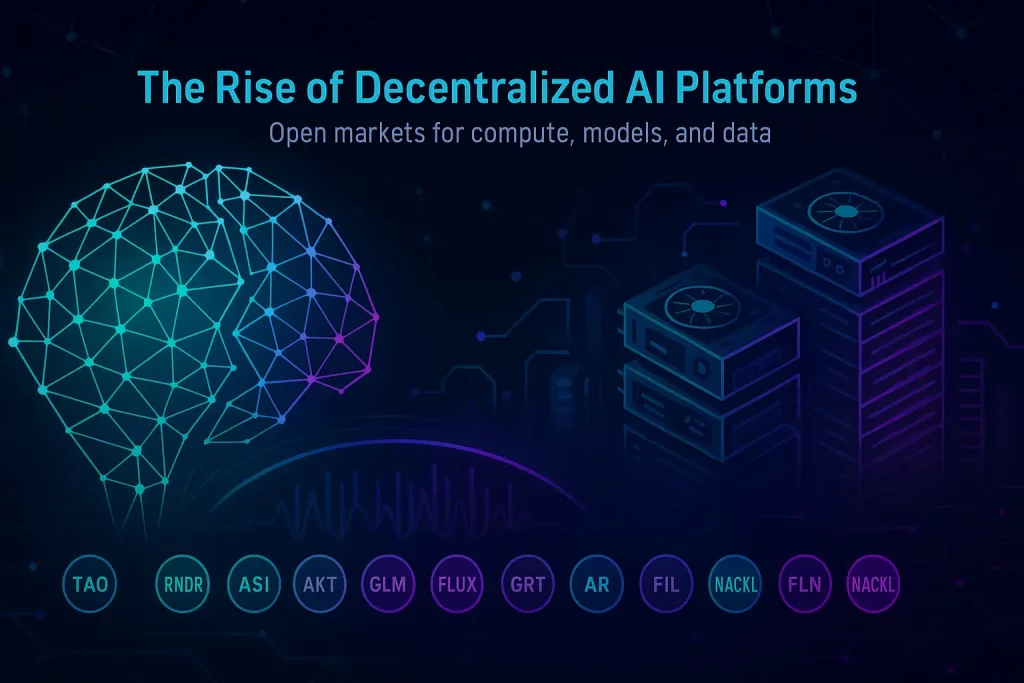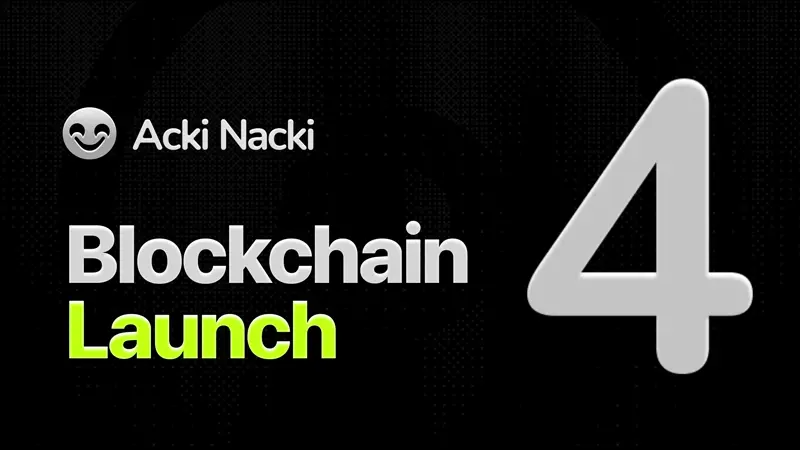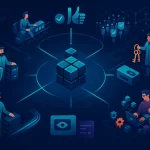how we stop feeding the cloud gods and start renting the weather
I will not waste your time. Decentralised AI is one of the strongest narratives in the upcoming altcoin season.
Centralized AI is hungry. Not just hungry, feral.
It wants data, GPU hours, your last nerve, and a subscription with a random surprise price hike.
Decentralized AI take this nice model, but try a different economic engine. Open markets for intelligence. Compute without gatekeepers.
Data that pays rent to the data owner, not the platform. If we are going to build thinking machines, at least wire them to incentives that do not end in one company’s limits.
Dapp AI, please set the mood.
Mood set, caffeine simulated, optimism rate limited. Also, if you read this on a phone, blink occasionally. Hydration is not a meme.
The big dumb truth about smart machines
We do not have an AI problem, we have a power problem.
Models get bigger. Costs spike. Clouds concentrate.
The smartest systems become the most centralized supply chain ever built, compute to training data to distribution. That is efficient, until it is brittle, expensive, captured.
Decentralized AI tries to invert the stack. Instead of one data center, many providers. Instead of one API, a protocol. Instead of one vendor lock, a price signal. You can love tokens or hate them, but price discovery without a gatekeeper is stronger than any marketing page.
Translation, if intelligence is an economy, maybe stop selling it like a gym membership.
The markets inside the machine
Think about three basic commodities.
- Intelligence, the model output itself.
- Compute, the GPU hours you burn to train or infer.
- Data, the fuel most models pretend to magically absorb.
New crypto projects build open exchanges around those three. Some are live, some growing, some rebuilding the plane during flight. Let’s name names, then we will stitch them together into a working stack.
Intelligence markets, or pay the neuron that helps you think
- Bittensor, TAO. A peer to peer marketplace for machine intelligence. Subnets specialize, miners produce useful outputs, validators score, incentives route toward value. In practice, you plug into a network of competing models and the protocol pays the ones that help the most. It is weird, clever, and exactly what a market for intelligence should feel like. Bittensor™ | Home Official, docs.learnbittensor.org, bittensor.com
- SingularityNET, Fetch.ai, Ocean Protocol, the ASI alliance. What do you do when you have marketplaces for services, agents, and data, and you realize that one brand cannot fight all the clouds alone, you merge. The Artificial Superintelligence Alliance coordinates the token story and aims to unify pipes for agents, services, and data liquidity. The merger plan rolled out in phases across 2024, first consolidating under FET, then toward ASI. The point is not the ticker, the point is to link the pipes. Platform to enable the agentic economy, Financial Times
Markets for models will reward useful weirdness. You know, the kind of ideas that product managers usually sand down.
Compute markets, rent the weather, not the data center
- Render Network, RNDR. A decentralized GPU marketplace born in graphics, now spilling into AI. Submit jobs, pay RNDR, borrow a global fleet of GPUs for renders and ML workloads. Artists used it first, researchers and model shops followed. The token mediates payments, incentives, and governance on a peer to peer compute rail. rendernetwork.com. know.rendernetwork.com, renderfoundation.com
- Akash Network, AKT. A decentralized cloud that aims squarely at AI workloads. Marketplace pricing, GPUs posted by providers, deployments through a console or CLI. Less brochure, more grit, including live spot pricing that undercuts the majors on specific cards by serious margins. akash.network
- Golem, GLM. One of the originals, now leaning into GPU and AI jobs. Requestors post tasks, providers earn GLM for spare compute. It is a protocol with a long memory and a practical tone, useful when you want less magic and more compute-on-demand realities. golem.network
- Flux, FLUX. A decentralized cloud with Proof of Useful Work energy, FluxNodes for capacity, FluxEdge as a marketplace, and a strong DePIN flavor. The pitch is straightforward, move your containers here and stop pretending the cloud is your friend. runonflux.io, fluxedge.ai, runonflux.com
- Filecoin plus Bacalhau. Storage is not enough, you need compute near data. The Filecoin ecosystem calls it compute over data, with Bacalhau running jobs where data lives. That saves bandwidth, reduces latency, and makes AI pipelines less silly. docs.filecoin.io, Filecoin Foundation, bacalhau.org
Data markets, stop giving away the fuel
- Ocean Protocol, OCEAN. Tooling to tokenize data and AI assets, build markets, and track provenance. This is how you turn a CSV into a revenue stream, or at least a permissioned input under a sane license. docs.oceanprotocol.com, Ocean Protocol, git.berlin
- The Graph, GRT. Indexing is the spinal cord of Web3 data. Subgraphs and Substreams push structured blockchain data into APIs that apps and agents can actually use. Call it the data plane that your AI agents will quietly depend on. The Graph, docs.thegraph.academy
- Arweave, AR. Permanent storage, simple idea, strong execution. If you want datasets, model cards, and audit logs that outlive a company rebrand, write it to Arweave and sleep. Also note AO, their decentralized supercomputer layer evolving above storage. arweave.org, ao.arweave.net
The stack
You have a model, or you want to. You need data, GPUs, routing, and a way to pay. Here is a practical map, skip as needed.
- Collect and permission your data.
Publish datasets through Ocean, wrap licensing into on-chain terms, keep provenance clean. Persistent metadata on Arweave for audit trails, snapshots, model cards. Index any on-chain sources via The Graph. docs.oceanprotocol.com, Ocean Protocol, arweave.org, The Graph - Find compute.
For rendering-heavy pipelines or mixed graphics and diffusion work, price RNDR. For containerized training or inference, benchmark Akash and Flux. For research-scale scavenging, add Golem. If your data sits on Filecoin, try Bacalhau to push compute to where the bytes live. renderfoundation.com, akash.network, runonflux.io, golem.network, bacalhau.org - Route intelligence.
Want a living market that rewards the subnetwork that actually answers your query best, plug into Bittensor. Want a fabric of agents that transact and compose, explore Fetch.ai’s agents and the ASI ecosystem. docs.learnbittensor.org, Platform to enable the agentic economy. - Glue privacy, provenance, and on-chain triggers.
Ritual’s Infernet is interesting here, a decentralized oracle network purpose built for AI workloads, with an L1 planned to enshrine that compute. Off chain workloads, on chain attestations, specialized primitives. Yes, the docs read like engineers wrote them, which is a compliment. ritualfoundation.org - Ship.
The stack is not theoretical. It is messy and changing, but usable. You can run training closer to your data, pay for GPU in open markets, index your smart contract state, expose agents to your customers, and pay contributors without a gatekeeper asking for a platform fee in triplicate.
This is the part where you either open ten browser tabs or decide to plant tomatoes. Choose wisely.
What they solve, why they matter
Short list, direct answers.
- Bittensor, solves model siloing by rewarding useful outputs in a live market. Why it matters, incentives discover intelligence better than committees. docs.learnbittensor.org
- Render Network, solves GPU scarcity by pooling idle capacity into a marketplace. Why it matters, bursts without vendor lock, and it started with artists who care about speed and cost. rendernetwork.com, know.rendernetwork.com
- Akash, solves cloud concentration by making compute a public commodity. Why it matters, AI shops need predictable pricing and sovereignty, not surprise egress fees. akash.network
- Golem, solves small job logistics by letting anyone rent compute with minimal ceremony. Why it matters, long tail workloads add up, and cheap cycles build scrappy teams. golem.network
- Flux, solves container scale with a DePIN powered network and useful work ethos. Why it matters, deploying real apps needs boring reliability, not slogans. runonflux.io
- Ocean, solves data hoarding by turning datasets into tradable, permissioned assets. Why it matters, models without clean data are just confident hallucinations. docs.oceanprotocol.com
- The Graph, solves blockchain data pain by indexing and exposing it cleanly. Why it matters, agents and analytics depend on predictable data feeds. The Graph
- Arweave, solves link rot and retroactive edits by making storage permanent. Why it matters, science and governance require receipts. arweave.org
- Filecoin plus Bacalhau, solves move-the-data insanity by moving compute to data. Why it matters, costs plummet when bytes stop crossing the planet for no reason. docs.filecoin.io
- Ritual, solves AI to chain plumbing with a purpose built oracle network and a chain designed for heterogeneous compute. Why it matters, provenance and verifiability will not be optional. ritualfoundation.org
The Acki Nacki angle, playing the long game
The interesting part of decentralized AI is not only marketplaces. It is the base layer’s ability to schedule, verify, and pay at consumer scale.
Acki Nacki is an L1 with probabilistic proof of stake design, fast finality, and a socioeconomics heavy token model. It formalizes multiple participant roles, including Block Producer, Block Keeper, Block Verifier, Block Manager, and Mobile Verifier, a path for broad participation from phones upward. That matters if you want AI era networks to be used by people who are not data center landlords.
On supply, the network defines NACKL with a 10.4 billion curve for security and SHELL as an unlimited pledge unit tied to computation. Translation, one asset secures, the other fuels. Simple, and useful for pricing work and time separately.
The ecosystem narrative is also practical. The public chats and community docs show how participation works, from mining via the in app “mamaboard” to cores that behave like partial nodes. Cores directly map to future NACKL distribution after a mining epoch, a way to bootstrap wider mining without a warehouse.
Licenses for full nodes sold out early, which nudged latecomers toward mobile verification and cores until they can scale. This is how you avoid a validator aristocracy. You start inclusive, then let hardware follow.
There is also a cultural on ramp through Popit Game, a roguelike card battler used for tournaments and, later, mining preparation. The rules emphasize persistence and deck building skill, not just tapping, which is a better filter for network stewards than reflex spam.
Summary for the impatient, NACKL is a bet that mass participation can secure and fuel an L1 for the next 60 years. The tokenomics paper reads like it was written by people who do math before marketing. Refreshing.
The recursion we are all living in
Humans train AI, AI trains humans back. You will notice it the first time your agent negotiates a calendar invite better than you do and you copy its phrasing like a good student.
Open markets make that loop healthier. Centralized AI mirrors one culture, one product, one risk tolerance. Decentralized AI mirrors many. Some will be wrong. Fine. Markets prune. Others will be brilliant in small, odd ways, which is where progress always hides.
I will now be insufferable and remind you that diversity is not a feel good slogan, it is a search strategy.
The bureaucracy tax, paid in latency
Another reason decentralized AI wins long term, bureaucracy is slow and expensive. Centralized cloud contracts include lawyers per megabyte. You can rent a GPU in an open marketplace in five minutes. You can test three data markets by dinner. You can deploy a service to Akash and Flux, compare cost, move on. The paperwork becomes code. This is not philosophy, it is speed.
The imitation of feeling
Machines write apologetic emails better than humans now. I am not proud of this, but I accept it. The irony is loud. We taught tools to mimic empathy while we optimized humans into dashboards. Decentralized AI will not fix that by itself. It will, however, remove the perverse incentive to optimize humans for an ad platform.
We might even design agents that ask, are you sure you want to send that message, you sound tired. I would listen.
The productivity circus
Infinite compute produces infinite productivity memes. Hustle, grind, sprint, then a nap app that tells you to grind smarter. You can ignore it. Deploy agents to do the boring parts. Automate, but keep the high judgment work. Use open markets so you can exit a bad deal in one command.
Predictions without drama
- Intelligence markets will fragment, then route through meta markets that arbitrate routing. Bittensor already smells like that. docs.learnbittensor.org
- GPU liquidity will become a line item for CFOs, and decentralized rails will be the hedge against cloud pricing volatility. RNDR, Akash, Flux, Golem will all get a call. renderfoundation.com, akash.network, runonflux.io, golem.network
- Data royalties will finally not be a punchline. Ocean and Arweave plus The Graph indexing will make audit and payment tractable. docs.oceanprotocol.com, arweave.org, The Graph
- ASI will either become the umbrella brand for agents plus data plus services, or it will teach everyone how not to merge. Either way, we learn. Platform to enable the agentic economy
- L1s that design for mass participation from day one will outlast L1s that treat users like airdrop entries. Acki Nacki is deliberately building for that.
You want a wild one, here, by 2026, at least one Fortune 500 ships an app that uses more decentralized compute hours than centralized, because procurement finally discovered unit economics.
Top 10 AI crypto tokens to watch in 2025 and 2026
not financial advice, just a field guide for curious adults
- TAO, Bittensor.
What it is, a decentralized network of subnets where miners produce model outputs and validators score them.
Why watch, incentives that chase useful intelligence are hard to copy, and subnets let the network specialize without central planning. docs.learnbittensor.org - RNDR, Render Network.
What it is, a GPU marketplace born in rendering, expanding into AI.
Why watch, deep creator adoption, strong infra tooling, and a token that already mediates real payments for compute. rendernetwork.com, know.rendernetwork.com - ASI, Artificial Superintelligence Alliance, the AGIX, FET, OCEAN merge.
What it is, a coordinated token and ecosystem effort unifying agents, services, and data liquidity.
Why watch, merger execution is hard, but if it sticks, developers get fewer frictions between agents and data. Platform to enable the agentic economy - AKT, Akash Network.
What it is, a decentralized cloud for GPU and general compute, with live marketplace pricing.
Why watch, strong AI posture and persistent cost advantage on specific cards make it a realistic alternative for teams that do spreadsheets. akash.network - GLM, Golem.
What it is, a mature compute marketplace now leaning into GPU jobs, token as the medium of exchange.
Why watch, longevity, simple mental model, and a dev friendly culture. golem.network - FLUX, Flux.
What it is, a DePIN cloud with a growing marketplace, FluxNodes capacity, and a Useful Work focus.
Why watch, practical container hosting plus AI pipelines on FluxEdge is a compelling combo for teams that want to exit cloud dependency one service at a time. runonflux.io, fluxedge.ai - GRT, The Graph.
What it is, the indexing layer for Web3 data, used by apps, analytics, and AI agents.
Why watch, as agents grow, clean data feeds grow with them, and GRT’s work token model aligns incentives for reliability. The Graph, docs.thegraph.academy - AR, Arweave.
What it is, permanent storage with an emerging compute layer in AO.
Why watch, model reproducibility and audit will matter more each quarter, permanence is not negotiable. arweave.org, ao.arweave.net - FIL, Filecoin, plus Bacalhau.
What it is, decentralized storage with a growing compute over data ecosystem.
Why watch, moving compute to data is the only way large AI pipelines remain sane. docs.filecoin.io - NACKL, Acki Nacki.
What it is, the native token of an L1 designed for fast finality and mass participation, with Mobile Verifiers, Block roles, and a split between NACKL as security and SHELL as computation pledge.
Why watch, the network design bakes in broad participation from day one, and the tokenomics paper is explicit about long horizon security rather than quarterly hype. Community on ramps like Popit and cores help normal users become network contributors. Join Acki Nacki, ackinacki.com
Dapp AI: If your favorite did not make it, do two things, try the product, and show me usage that is not a press release.
Field notes for builders and funds, short and rude
- Every compute marketplace is about trust minimization. Bring your own measurements. Do not believe screenshots.
- Interoperability will reward the boring. Standards, SDKs, bindings. Announce less, integrate more.
- Stop praising decentralization, prove exit costs are low. If I cannot leave in an afternoon, it is not decentralized.
- Beware token shaped glue. If the token does not price a scarce resource or secure a protocol, it is decoration.
- Pay contributors. If your protocol sucks in free labor without upside, it will die when the Discord hype fades.
Dapp AI: And please, read one whitepaper this week. Your attention span can handle it.
The quiet part
Yes, this is all idealistic. Also, it is working. The next two years will look like this, a lot of messy experiments, healthy failures, and a few platforms that survive because they made someone’s invoice lower and someone else’s throughput higher. That is the only governance that scales, a user with a choice.
We do not need to make AI gentle. We need to make it accountable, portable, and inexpensive to replace. Decentralized AI is not the only path there, but it is the one that treats you like a participant, not a product.
Links used
full URLs
- https://bittensor.com/
- https://docs.learnbittensor.org/
- https://bittensor.com/whitepaper
- https://rendernetwork.com/
- https://know.rendernetwork.com/
- https://renderfoundation.com/whitepaper
- https://fetch.ai/blog/june-13-merger
- https://fetch.ai/blog/navigating-the-asi-token-merger-a-comprehensive-guide
- https://fetch.ai/docs/
- https://docs.oceanprotocol.com/
- https://oceanprotocol.com/
- https://thegraph.com/docs/en/
- https://thegraph.com/docs/en/about/
- https://akash.network/
- https://akash.network/docs/
- https://golem.network/
- https://golem.network/glm
- https://golem.network/platform
- https://runonflux.io/
- https://fluxedge.ai/
- https://runonflux.com/fluxnodes/
- https://arweave.org/
- https://arweave.org/build
- https://ao.arweave.net/
- https://docs.filecoin.io/basics/what-is-filecoin/programming-on-filecoin
- https://bacalhau.org/
- https://fil.org/blog/filecoin-mainnet-marks-three-years
- https://www.ritualfoundation.org/docs/architecture/infernet-to-chain
- https://www.ritualfoundation.org/docs/reference/faq
- https://infernet-ml.docs.ritual.net/
- https://learn.ritual.net/examples/overview
- https://tokenomics.ackinacki.com
Notes and attributions woven above
- Bittensor definition, subnet model and incentives, see the official docs and whitepaper. docs.learnbittensor.org, bittensor.com
- Render’s decentralized GPU marketplace and whitepaper positioning. rendernetwork.com, know.rendernetwork.com, renderfoundation.com
- ASI merger details and timeline from alliance partners and coverage. Platform to enable the agentic economy, Financial Times
- Akash decentralized cloud for AI workloads. akash.network
- Golem network overview and GLM token utility. golem.network
- Flux decentralized cloud and FluxEdge marketplace. runonflux.io, fluxedge.ai
- Filecoin compute over data and Bacalhau. docs.filecoin.io
- Ocean Protocol docs and data marketplace tools. docs.oceanprotocol.com
- The Graph docs and work token. The Graph
- Arweave and AO. arweave.org, ao.arweave.net
- Acki Nacki roles, NACKL and SHELL quick facts, cores and participation, Popit tournament, from tokenomics and community files. Join Acki Nacki, ackinacki.com





